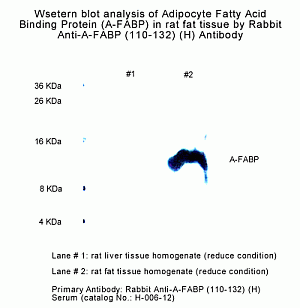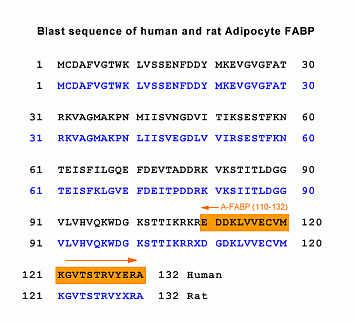|
|
Adipocyte Fatty Acid Binding Protein (AFABP) A Biomarker for Metabolic Syndrome
BACKGROUND: Adipocyte-fatty acid binding protein (A-FABP), a major cytoplasmic protein in adipocytes, plays a central role in the development of diabetes and atherosclerotic cardiovascular disease in experimental animals. We have previously shown that A-FABP is present in the bloodstream and that its circulating levels correlate with metabolic risk factors in a cross-sectional study. In the present study, we further evaluated the prospective association of A-FABP with the metabolic syndrome (MetS) as defined by the updated National Cholesterol Education Program criteria.
METHODS AND RESULTS: In the present study, 495 nondiabetic adults from the population-based Hong Kong Cardiovascular Risk Factor Prevalence Study were prospectively followed up for 5 years. The relationship of serum A-FABP with the MetS and its components was investigated. At baseline, high A-FABP levels were associated with the MetS (odds ratio, 4.0; 95% CI, 1.5 to 10.4; highest versus lowest sex-specific tertile, adjusted for age, body mass index, the homeostasis model assessment index for insulin resistance, C-reactive protein, and adiponectin, P=0.005). On long-term follow-up, subjects with higher baseline A-FABP levels had progressively worse cardiometabolic risk profile and increasing risk of the MetS. Among 376 subjects without the MetS at baseline, 50 had developed it at 5 years. Apart from the homeostasis model assessment index for insulin resistance (P=0.001), baseline A-FABP was the only independent predictor of the development of the MetS during the 5-year follow-up (odds ratio, 4.7; 95% CI, 1.8 to 11.9; highest versus lowest sex-specific tertile, P=0.001, adjusted for the homeostasis model assessment index for insulin resistance and body mass index). A-FABP was predictive of the MetS even after adjustment for each of its individual components.
CONCLUSIONS: Circulating A-FABP predicts the development of the MetS independently of adiposity and insulin resistance.
Xu et al. Circulation. 2007 Mar 27;115(12):1537-43
AIM: Plasma adipocyte fatty acid binding protein (A-FABP) and epidermal fatty acid binding protein (E-FABP) concentrations have been linked to obesity and the metabolic syndrome. In this study, we investigated whether plasma A-FABP and E-FABP concentrations are altered by weight loss in obese patients.
Methods: In a prospective study, fasting plasma A-FABP and E-FABP concentrations were measured before and 6 months after gastric banding in 33 morbidly obese patients, with a body mass index (BMI) of 46 +/- 5 kg/m(2). Eleven healthy subjects with a BMI < 25 kg/m(2) served as controls.
Results: A-FABP and E-FABP plasma concentrations were higher in obese subjects (36.7 +/- 6.7 and 3.7 +/- 0.7 ng/ml, respectively) than in controls (18.1 +/- 0.6 and 2.6 +/- 0.5, respectively, p < 0.01). Gastric banding reduced BMI to 40 +/- 5 kg/m(2), A-FABP to 32.6 +/- 5.4 ng/ml and E-FABP to 1.9 +/- 0.7 ng/ml (all p < 0.05) after 6 months. Insulin sensitivity as estimated by the Homeostasis Model Assessment insulin resistance index was unchanged. A-FABP concentrations were significantly associated with BMI before and 6 months after surgery (p < 0.05, r = 0.42 and r = 0.37 respectively).
Conclusions: Elevated plasma A-FABP and E-FABP concentrations in morbidly obese subjects are reduced after gastric banding-induced weight loss. This suggests that FABP may be associated with improvement of metabolic conditions over time.
Haider et al. Diabetes Obes Metab. 2007 Sep;9(5):761-3.
 
|
|
|
%006-12%
|
|
|


